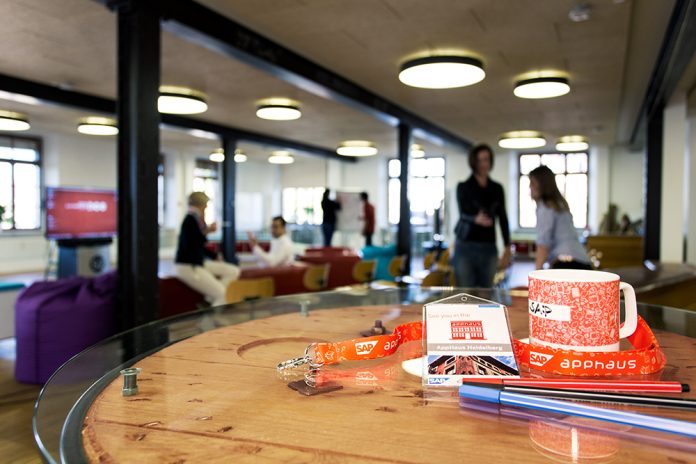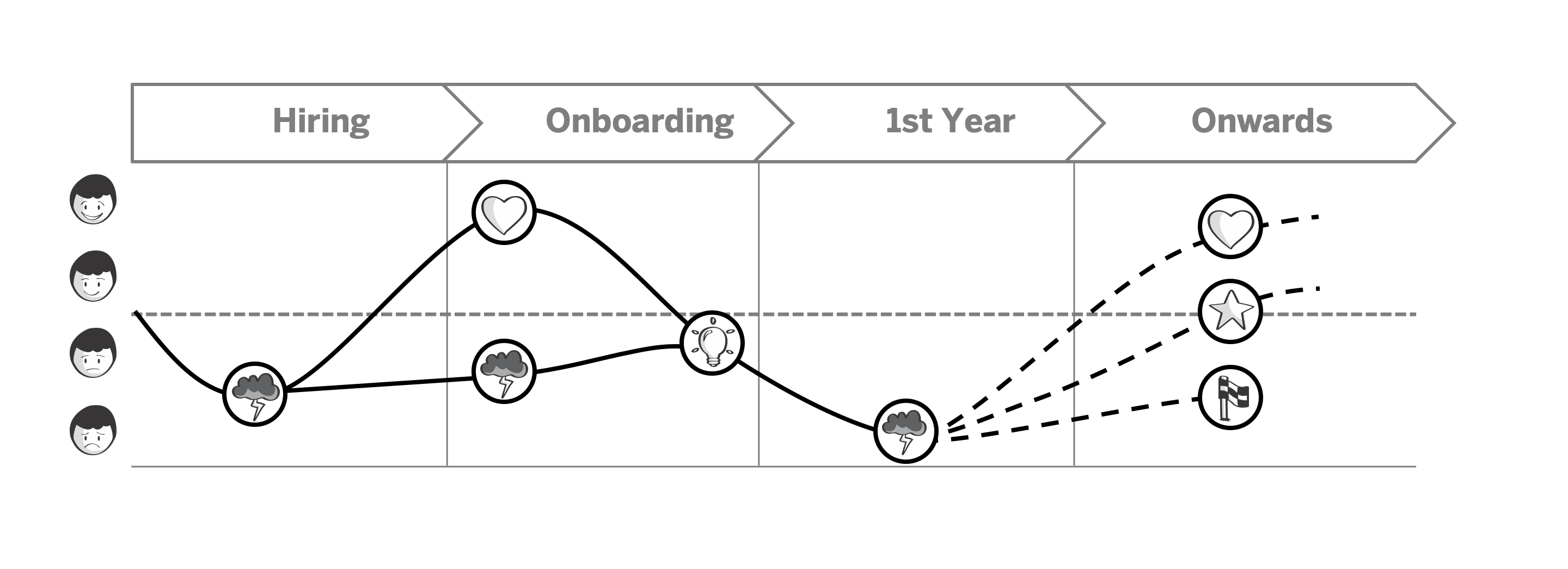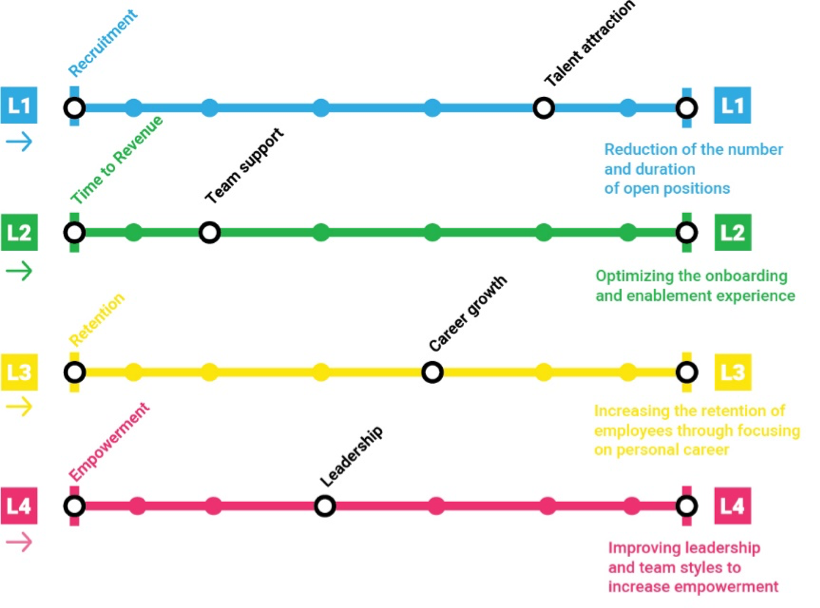Toby and Daniel were corporate rebels. Meeting at SAP in 2005 their approach to work – challenging the current way of doing things, questioning authority, taking a collaborative approach to solving problems – might not seem out of place today, but it certainly ruffled a few feathers back then. In a massively successful German multinational that sold software, their design thinking led style of working seemed out of place. Design excels in situations that are messy, ambiguous, uncertain. Where is the value for a German giant that runs by the numbers?
Today in 2019 they are forging a new identity for themselves by focusing on the numbers. They have calculated financial savings of over €10M for a commercial sales unit of 400 staff by making small improvements in their wellbeing. And that €10M is based on very conservative estimates.
Their initial identity at SAP was linked to the now renowned AppHaus. What to do with corporate rebels when you’re not quite sure what to do with them? Set them free of course, but keep them inside. As founding members of the AppHaus they were involved in the typical entrepreneurial experience of deciding where to position the doors and power sockets in a new workspace, recruiting talent to drive forward – and also re-designing the payroll experience for thousands of customers worldwide. From humble beginnings as a low-risk experiment in Heidelberg, board members would eventually come to them for advice, and the AppHaus today numbers 82 personnel between its original Heidelberg location and Palo Alto, Korea, Berlin and New York, functioning as a centre of expertise for the messy problems in the company.
SAP played a key role in making design thinking what it is today. The same year that Toby and Daniel met, SAP co-founder Hasso Plattner donated €35M to Stanford University to form the Hasso Plattner Institute of Design, or D-School. I was a visiting researcher at Stanford Design a few years before that donation, interviewing Stanford Professor and IDEO co-founder David Kelley and his colleagues in the Palo Alto studio. The D-School, with Kelley and IDEO, would form a perfect mix to create a global movement, and SAP was one of the early champions to implement design thinking on a corporate level, in turn bringing it to their corporate customers.
So what has design got to do with wellbeing? And further, the measurement of financial benefits? Design is about humans and looks to identify and satisfy human needs. Well-being considers our states of being – physically, mentally, socially and so on – and whether they are positive or negative. In The European Business Review, we have looked at how design may be leveraged to improve health and wellbeing at work, from an ethnographic approach to an executive life to a design for wellbeing framework and how we may re-design the physical and social environment for behaviour change.
In all, the key is the close examination of the experience and particularly how that experience, and related needs, change over time. What Toby and Daniel did was to analyse the experience of commercial sales staff, from recruitment and onboarding to learning the ropes during their first year, until they move on from the role, either changing functions within the company or leaving the company altogether. As Daniel mentions this “keeps the employee in focus, rather than just checking a box.”
Figure: The employee experience journey for SAP commercial sales EMEA, simulating extreme emotions
Combining with their focus on happiness and wellbeing that we discussed in part 1 of this study last month they looked at how different interventions at each stage could improve the employee experience. Interventions included providing learning at the right time, increased peer support through coaching, and changes in organizational design so that first line managers don’t always get pulled into the sales thrust. In all, they are helping to address the most acute ‘pain points’ to make people happier and improve their wellbeing.
Different scenarios were created, from filling vacant positions to improving performance and simply having trained staff in position for longer. Happy employees don’t tend to leave.
And the benefits are astonishing. Having an experienced employee in post one month longer is equivalent to a saving of €3.5M. This includes the typical ‘overachieving’ profile of a 3rd year employee of 120% of target, and the costs associated with recruiting and training someone new, with 1st year employees generally hitting 40% of target.
Of course, there are assumptions in these calculations, yet design thinkers are experts in challenging assumptions. This is why I believe their assertion that the €10M savings are conservative (and dare I say it, two Germans would not be accustomed to hyperbole!) Much of the focus on calculating the return on wellbeing has stalled on the negative side of wellbeing at work; reducing sickness and absenteeism, yet this takes a very narrow view of health that has no link to performance.
Figure: Value generating paths for a culture of wellbeing
SAP commercial sales in EMEA has provided the perfect platform for this analysis. Sales have an inherent focus on the numbers with plenty of available data. 400 employees is big enough to see the benefits yet not too big to control. And in having a function where the average tenure is 20 months the employee journey is simple enough to examine in its entirety and identify interventions that will make a difference to their wellbeing. We move beyond a narrow wellbeing program to a culture of wellbeing that includes learning, peer support, and empowerment. Local empowerment is key, with Toby stating that “local operations shouldn’t wait for some global magic to happen.” Light touch, high impact interventions depend on addressing the unique needs of a specific location.
Banging the drum of wellbeing at the heart of business may be reserved for the rebels of 2019. In the near future, and supported by significant financial benefit on the positive case, it may well be a more strategic concern – and so be a part of everyone’s job.
 Dr. Steven MacGregor is the CEO of The Leadership Academy of Barcelona [LAB] an executive education provider and management consultancy with clients including McKinsey, Telefónica and Uber. A Visiting Fellow at the Glasgow School of Art he teaches on open and custom programs at IMD, IE, IESE and CEIBS. Formerly a visiting researcher at Stanford and Carnegie-Mellon he is the author of Chief Wellbeing Officer (LID 2018)and Sustaining Executive Performance (Pearson 2015). His twitter handle is @spmacg.
Dr. Steven MacGregor is the CEO of The Leadership Academy of Barcelona [LAB] an executive education provider and management consultancy with clients including McKinsey, Telefónica and Uber. A Visiting Fellow at the Glasgow School of Art he teaches on open and custom programs at IMD, IE, IESE and CEIBS. Formerly a visiting researcher at Stanford and Carnegie-Mellon he is the author of Chief Wellbeing Officer (LID 2018)and Sustaining Executive Performance (Pearson 2015). His twitter handle is @spmacg.





































